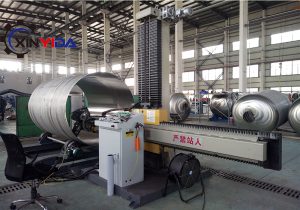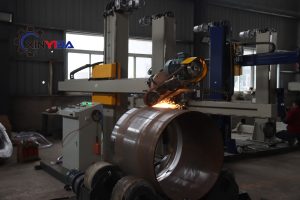In the world of industrial manufacturing, precision is everything. Whether it’s producing tanks for storage, transportation, or military use, the final quality of the product is determined by the accuracy and care taken at each stage of production. One of the most critical steps in ensuring tanks meet their required specifications is polishing, a process that involves the use of specialized equipment known as tank polishing machines.
Tank polishing machines play a significant role in the precision tank manufacturing process, helping to enhance the overall finish, durability, and performance of the product. This article will delve into why tank polishing machines are crucial for precision tank manufacturing and how they contribute to the quality of the final product.

Ensuring Surface Finish and Aesthetic Appeal
One of the primary functions of tank polishing machines is to achieve a smooth, reflective surface on tanks. Whether the tanks are made from stainless steel, aluminum, or other materials, a high-quality finish is essential not only for aesthetic purposes but also for functional reasons.
-
Aesthetic Appeal: For industries such as food, beverage, or pharmaceutical manufacturing, tanks must meet strict hygienic and aesthetic standards. Polishing the tank surface ensures that it is free from defects like scratches, weld marks, or unevenness that may compromise its appearance.
-
Hygiene Compliance: In some industries, such as food processing, the tanks’ surfaces must be polished to prevent contamination. A smooth surface is easier to clean and sanitize, preventing the buildup of bacteria or other harmful substances. This is particularly important when tanks are used for storing sensitive materials like chemicals, oils, or consumables.
Improving Durability and Resistance
Tank polishing is not just for looks—it’s also crucial for enhancing the durability and longevity of the tanks. During the manufacturing process, tanks undergo welding and other operations that can cause surface imperfections. These imperfections, if left untreated, can become points of weakness that lead to premature wear and tear, leaks, or even tank failure.
By using polishing machines, manufacturers can remove these imperfections and smooth out the surface, making it more resistant to damage from external forces such as abrasion, corrosion, or chemical reactions. This improves the overall lifespan of the tank, ensuring that it remains in good working condition for years to come.
Enhancing Corrosion Resistance
Corrosion is a major concern when it comes to tanks, especially those used in industries that involve exposure to harsh chemicals or extreme environments. Even slight surface irregularities can trap moisture, leading to rust and corrosion over time. Tank polishing machines help remove these imperfections and create a smooth, uniform surface that minimizes the risk of corrosion.
In addition to improving the tank’s physical properties, polishing machines are also used to apply protective coatings. These coatings provide an added layer of defense against corrosive substances, which is especially important for tanks used in marine or chemical industries where the risk of corrosion is higher.
Precision Manufacturing for Safety and Performance
In precision tank manufacturing, where every detail counts, tank polishing machines ensure that each component of the tank is built to exact specifications. From the inner and outer walls to the seams and joints, a polished tank will perform better and be safer to operate.
-
Consistent Wall Thickness: Polishing can also help in achieving uniform thickness throughout the tank’s walls, which is vital for ensuring that the tank can withstand the pressure it will face during its operational life. This is particularly critical for tanks used in applications like military vehicles, where even small inconsistencies could result in catastrophic failure.
-
Seamless Integration: During the manufacturing process, welding and joining of materials can leave behind rough spots or uneven surfaces. These irregularities could affect how the tank functions, causing leaks or problems with pressure containment. Polishing machines help smooth out these areas, ensuring that every seam and joint is perfectly integrated.
Optimizing Tank Efficiency
For tanks used in industrial applications like chemical or oil storage, the efficiency of the tank directly influences the overall operational efficiency of the facility. A well-polished tank can help in maximizing the effectiveness of fluid flow, minimizing friction, and optimizing the internal space.
In the case of storage tanks, a polished interior allows for smoother fluid transfer, reducing the likelihood of material buildup or clogging. This is crucial for maintaining the integrity and efficiency of the tank, ensuring that it works as intended without causing costly downtimes or maintenance issues.
Customizing Machines for Different Industrial Needs
Tank polishing machines offer manufacturers the ability to customize the polishing process based on the type of tank being produced and the specific requirements of the customer. With advanced controls, manufacturers can adjust parameters such as the speed, pressure, and abrasiveness of the polishing process to achieve the desired finish and performance.
For example, tanks used in high-precision environments like aerospace or military applications may require a finer polish to meet strict safety and performance standards. Polishing machines give manufacturers the flexibility to meet these needs and deliver a product that aligns with the precise specifications of each client.
Cost-Effectiveness of Automation in Tank Polishing
Tank polishing machines are often automated, which allows for greater consistency, speed, and cost-effectiveness in the manufacturing process. Automated machines can work faster and more efficiently than manual labor, reducing production time and increasing throughput.
Moreover, automation minimizes human error, ensuring that each tank is polished to the same standard every time. This consistency is essential in maintaining product quality and meeting the exacting standards required in industries such as food production, pharmaceuticals, and chemicals.
By investing in automated polishing machines, manufacturers can reduce labor costs and improve overall operational efficiency while maintaining high standards of product quality.
Environmental Considerations and Sustainability
In today’s manufacturing environment, sustainability is a growing concern. Tank polishing machines contribute to environmental responsibility in several ways. First, they help to minimize waste by efficiently removing surface imperfections without damaging the underlying material. This results in less scrap metal and wasted materials during production.
Second, modern polishing machines are often designed to reduce energy consumption and minimize the environmental footprint of the manufacturing process. By using advanced technologies and optimizing the polishing process, manufacturers can reduce both energy use and emissions associated with the production of tanks.
Conclusion
In conclusion, high-quality tank polishing machines are integral to precision tank manufacturing, offering a wide range of benefits that enhance product quality, durability, and performance. From improving surface finishes and corrosion resistance to ensuring uniformity and safety, these machines play a pivotal role in meeting the exacting standards required in various industries.
As industries continue to demand higher precision, efficiency, and sustainability, tank polishing machines will remain a key investment for manufacturers striving to meet these needs. By incorporating advanced polishing technology into the production process, manufacturers can ensure that their tanks meet the highest standards of quality and performance, ultimately leading to greater customer satisfaction and long-term success in the marketplace.

